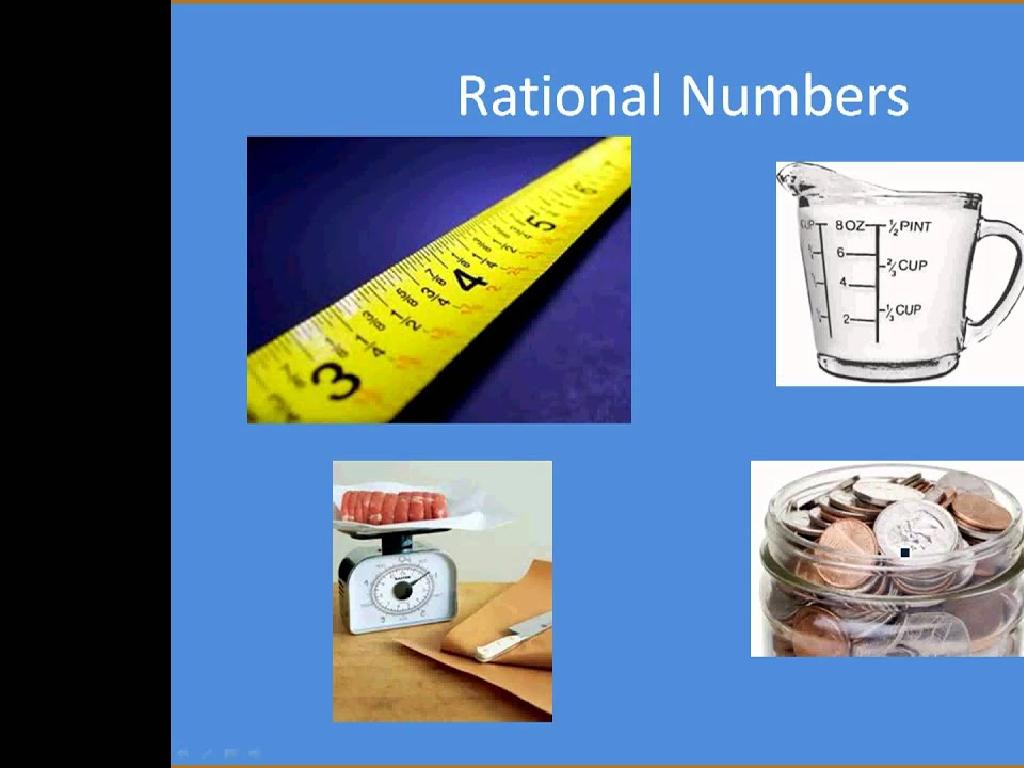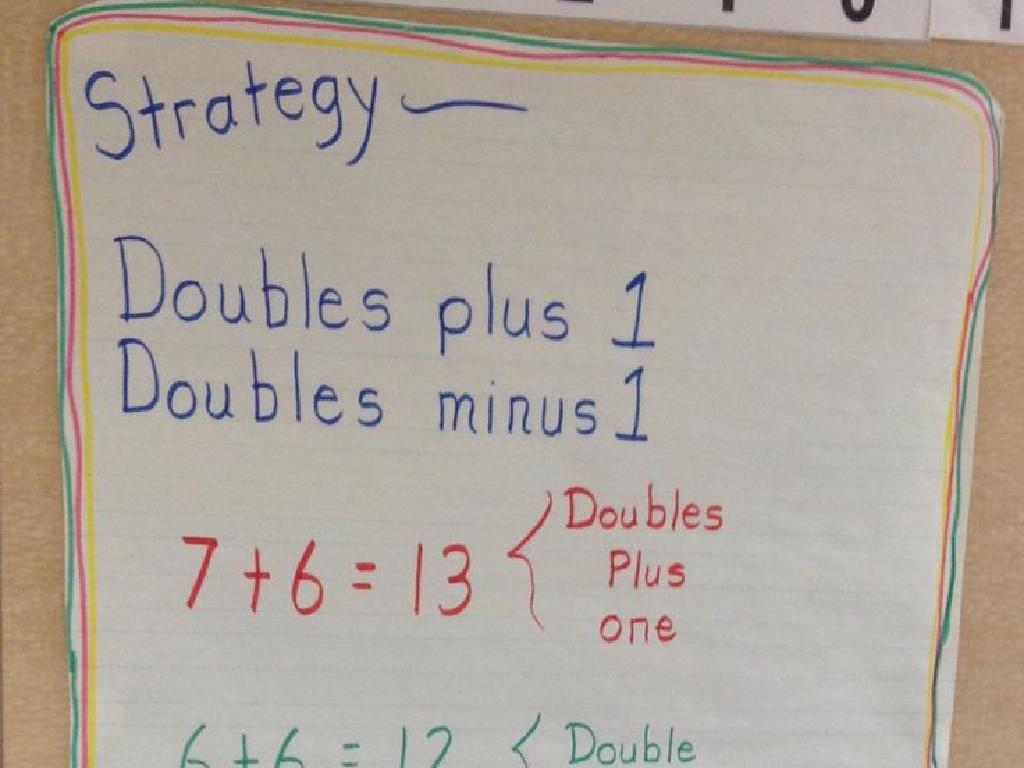Find Missing Angles In Quadrilaterals Ii
Subject: Math
Grade: Eighth grade
Topic: Two-Dimensional Figures
Please LOG IN to download the presentation. Access is available to registered users only.
View More Content
Finding Missing Angles in Quadrilaterals
– Define quadrilateral
– A four-sided polygon with four angles
– Sum of angles in a quadrilateral
– The total angles always sum up to 360 degrees
– Calculate missing angles
– Use algebra to find unknown angles
– Practical applications
|
Begin the lesson by defining a quadrilateral and discussing its properties, emphasizing that it has four sides and four angles. Review the concept that the sum of the interior angles in any quadrilateral is 360 degrees. Explain how to use this information, along with algebraic equations, to solve for missing angles when given some angle measurements. Highlight the importance of understanding angles in real-world contexts, such as engineering and design. Provide examples of different quadrilaterals (square, rectangle, trapezoid, etc.) and demonstrate finding missing angles in each case. Encourage students to think about where they might need to use this knowledge outside of the classroom.
Quadrilateral Basics: Angles and Types
– Define quadrilaterals
– A shape with four sides and angles
– Explore types of quadrilaterals
– Square, rectangle, trapezoid, rhombus, etc.
– Understand angle properties
– Sum of angles in any quadrilateral is 360°
– Calculate missing angles
– Use angle properties to find unknown angles
|
This slide introduces students to the fundamental concepts of quadrilaterals. Begin with a definition, highlighting that all quadrilaterals have four sides and four angles. Discuss various types, such as squares, rectangles, trapezoids, parallelograms, and rhombuses, noting their unique properties. Emphasize that the total sum of internal angles in any quadrilateral is always 360 degrees. Teach students how to apply this knowledge along with other given angle information to solve for missing angles. Provide examples of different quadrilaterals with some angles given and ask students to calculate the missing angles. Encourage students to practice with a variety of quadrilateral types to reinforce their understanding.
The Angle Sum of Quadrilaterals
– Sum of angles is always 360°
– Proof of angle sum property
– Divide quadrilateral into triangles, sum angles in triangles
– Example: Find missing angle
– Given 3 angles, calculate the 4th using 360° – (sum of known angles)
– Practice with different quadrilaterals
– Apply property to squares, rectangles, and other quadrilaterals
|
This slide introduces the concept that the sum of interior angles in any quadrilateral is 360 degrees. Begin by explaining the angle sum property and why it holds true for all quadrilaterals. Demonstrate the proof by dividing a quadrilateral into two triangles and using the triangle angle sum property (the sum of angles in a triangle is 180°) to show that the quadrilateral’s angles add up to 360°. Provide an example where students calculate a missing angle given the other three angles. Encourage students to practice with different types of quadrilaterals to solidify their understanding. This foundational knowledge is crucial for solving more complex problems involving quadrilaterals.
Finding Missing Angles in Quadrilaterals
– Use algebra for unknown angles
– Apply equations to find angles when sum is 360°
– Rectangle missing angle example
– In rectangles, opposite angles are equal. Use this to solve.
– Trapezoid missing angle example
– For trapezoids, use the fact that adjacent angles are supplementary.
|
This slide is aimed at teaching students how to apply algebraic methods to find missing angles in quadrilaterals. Start by explaining that the sum of interior angles in any quadrilateral is 360 degrees. Then, use a rectangle as an example to show that opposite angles are equal, which can help simplify the problem. For trapezoids, highlight that adjacent angles along the same side are supplementary (add up to 180 degrees). Provide step-by-step solutions for each example, ensuring to demonstrate how to set up equations based on these properties. Encourage students to practice with additional examples and to verify their answers by adding all angles to check if they sum up to 360 degrees.
Let’s Practice Together: Quadrilateral Angles
– Class exercise on quadrilaterals
– Calculate missing angles in different quadrilaterals
– Discuss strategies for calculation
– How to approach the problem & useful tips
– Share and compare answers
– Explain your method and learn from peers
– Q&A to address confusions
– Opportunity to ask questions and get clarifications
|
This interactive slide is for a class exercise where students will apply their knowledge to calculate missing angles in various quadrilaterals. Encourage collaborative problem-solving and discussion of different strategies to find solutions. After the exercise, facilitate a session where students share their answers and methods, promoting peer learning. Conclude with a Q&A session to clarify any doubts and ensure understanding. Provide guidance on how to approach angle problems, remind them of the sum of angles in quadrilaterals (360 degrees), and offer tips like looking for supplementary and complementary angles. Prepare to offer at least 4-5 different quadrilateral examples for variety and to accommodate different student skill levels.
Real-World Application: Angles in Architecture
– Importance of angles for architects
Architects use angles to create stable, aesthetic structures.
– Quadrilaterals in design
Quadrilaterals are often used in frames and floor plans.
– Activity: Find local quadrilaterals
Look around your environment for quadrilaterals and note their angles.
– Discuss your findings
|
This slide aims to show students the practical application of understanding angles in real-world scenarios, particularly in architecture and engineering. Architects and engineers use angles to ensure buildings are safe and aesthetically pleasing. Quadrilaterals play a significant role in design due to their properties and stability. For the activity, students should identify quadrilaterals in their surroundings, such as windows, doors, or tables, and estimate or calculate the missing angles. This exercise will help them connect classroom knowledge with real-life examples. Encourage students to share their findings and discuss how quadrilaterals fit into various structures. Provide guidance on how to observe and measure angles in everyday objects.
Class Activity: Angle Detective
– Find missing angles in quadrilaterals
– Work in pairs for collaboration
– Present solutions to the class
– Explain your reasoning
– Share how you determined the angles, using properties of quadrilaterals.
|
This activity is designed to promote teamwork and critical thinking as students work together to solve puzzles involving missing angles in quadrilaterals. Provide students with a set of quadrilateral puzzles where they must calculate the missing angles using their knowledge of the properties of quadrilaterals (e.g., the sum of interior angles is 360 degrees). Encourage them to discuss their strategies and problem-solving methods with their partner. After completing the puzzles, each pair will present their solutions and explain the reasoning behind their answers. This will help reinforce their understanding and allow them to learn from each other’s approaches. Possible variations of the activity could include using different types of quadrilaterals, providing hints for more challenging puzzles, or incorporating a timed challenge to add an element of gamification.
Wrapping Up: Quadrilaterals & Looking Ahead
– Recap: Finding missing angles in quadrilaterals
– Homework: Complete the angles worksheet
– Worksheet focuses on applying today’s concepts
– Next class: Exploring circles
– We’ll learn about the properties of circles
– Review today’s lesson for mastery
– Ensure understanding of angle relationships
|
As we conclude today’s lesson on finding missing angles in quadrilaterals, remind students of the key strategies they’ve learned, such as using the sum of angles in a quadrilateral (360 degrees) and subtracting known angles. For homework, assign a practice worksheet that reinforces these concepts through various quadrilateral problems. Looking ahead, inform students that the next class will introduce the topic of circles, including terms like radius, diameter, and circumference. Encourage them to review the strategies from today’s lesson to solidify their understanding, as this will be crucial for their success in future topics.





